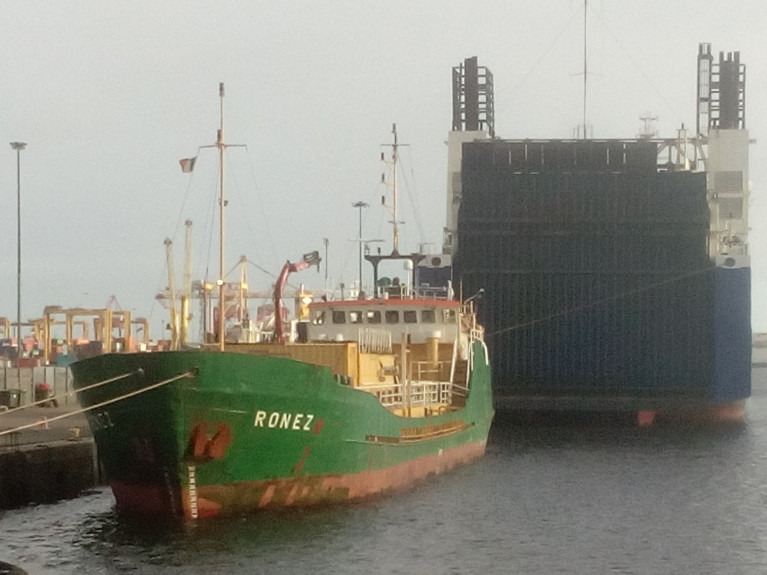It's refreshing for a change not to report on numerous big ships dubbed 'Brexit-Busters' that involve ro-ro freighters, ferries and containerships, but to focus on the smallest regularly calling cargoship to Dublin Port, writes Jehan Ashmore.
In fact having observed this cargoship's calls to the capital becoming more frequent last year and the first arrival in 2022 took place recently when the diminutive ship of just 870grt in question, the cement-carrier Ronez arrived into the port on Sunday, 2nd January.
This followed a passage from Great Yarmouth, in the UK and when in Dublin Bay a pilot from the cutter DPC Tolka transferred to the cargoship close to The Muglins off Dalkey. On board is an international crew of seven who work a 6-hour shift, then a rest for another 6 hours.
It was due to the New Year's Day Bank Holiday held on Monday, that the Channel Islands based cargoship had to occupy a 'lay-over' berth in Dublin Port upon arriving the previous day.
The lay-over involved the Ronez berth at the North Wall Quay Extension, close to the Tom Clarke (East-Link) Toll-Bridge. The cement-carrier remained there until shifting berths downriver to Ocean Pier, but not until the Wednesday.
On this occasion, Ocean Pier was where cement-products were loaded as exports for the Channel Islands, can otherwise take place opposite along the south bank at the Deepwater Berth. The ship's operator, Ronez Ltd, supplies the Islands also with aggregates, ready-mixed concrete, asphalt and precast concrete products.
As for cargoship's operations are concerned, Ronez is a self-pneumatic discharging vessel which can carry around 950 tonne of cement in two holds. This within the ship whose overall dimensions are as follows: length of 62.19m and on a beam of 10.03m.
So indeed this is a very small ship, yet the UK (Exeter) registered Ronez plays an important role carrying cargoes for the Channel Islands and in the trading of Irish cement exports.
Ronez this year marks a milestone as 2022 represents 40 years in service having been built in 1982 at the shipyard of Scheepswerf van Goor Monnickendam BV, in the Netherlands.
The cargoship also harks to an era of coasters that used to ply more so into Dublin Port until arguably in the main up to the late 1980's? This was at a time when observing such activity in a personal capacity led to logging a record of shipping movements and now includes use of AIS.
Also for a vessel of this vintage, Ronez has surprisingly kept its original name despite several ownerships, among them Huelin-Renouf Shipping that in late 2010, chartered-in the then brand newbuild Irish flagged Huelin Dispatch from Dundalk Shipping.
The Irish owned short-sea trader continued for other C.I. operations until 2013 but now is currently in Spanish waters while at anchorage off Algerciras in the Bay of Gibraltar.
Back to the Channel Islands where Ronez Ltd has island based operations at the Les Vardes Quarry and Vale Castle in Guernsey, where also the Ronez is based from its homeport of St. Sampson's Harbour. This is also where other operators import fuel and bulk-cargos to the small port that is nearby of St. Peter Port, the island's capital.
In addition, Ronez's run the St John’s Quarry in Jersey and so offers combined a range of construction materials for clients.
Quarrying activity on the Channel Islands, can be traced back to 1869 and continue to serve the island’s needs for quarried stone. Ronez has grown and developed the company over the years to produce precast materials, ready-mixed concrete, asphalt and undertake contracting services.
Another aspect for Ronez is the cargoship's importation to the Channel Islands of ground granulated blast-furnace slag (GGBS). Both cement and GGBS is transferred from the 500 tonne silo terminals in the Islands to the concrete and concrete-products manufacturing facilities.
Returning to Ronez in Dublin Port from where when the ship was laden with cement departed on Saturday morning at 06.30hrs. Some two days later to arrive in Guernsey having berthed at 11.30hrs in St. Sampson's South Commercial Quay.
Upon discharging cement, the coaster would be kept busy again as the ship last night made a passage to St. Helier, the capital on neighbouring Jersey.
The early hours inter-island passage was completed just shy of six hours using the 10-knot powered vessel's Stork Werkspoor main engines. This saw the ship arrive today just after 05.30hrs at St. Helier's Victoria Pier
So where will the next port of call be? for this small yet hard-working veteran vessel.






























































